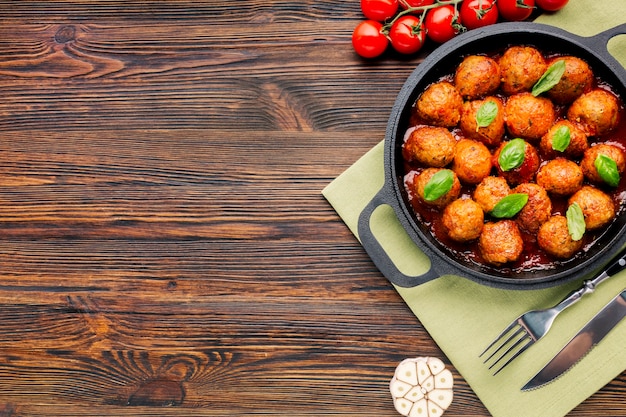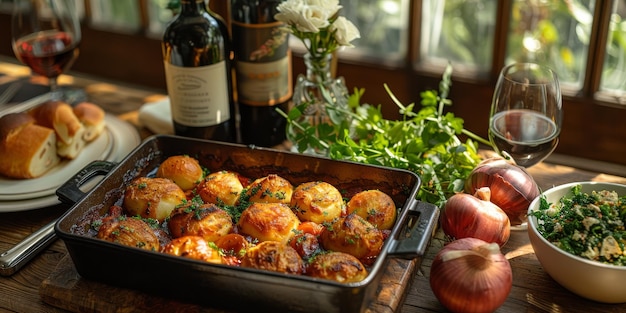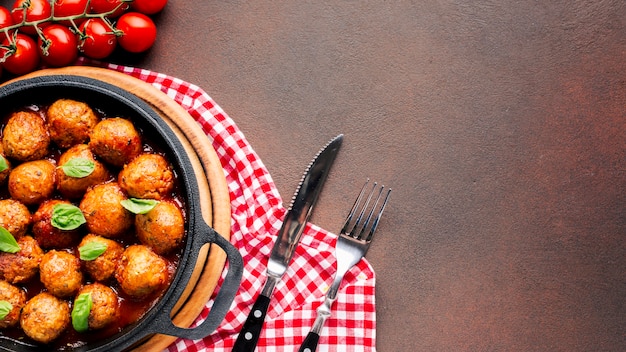Let's face it, meatballs are a culinary classic for a reason. They’re versatile, comforting, and always a crowd-pleaser. But sometimes, you want something more than just your standard pan-fried or simmered meatballs. That's where oven-baked meatballs come in. They offer a unique texture, a beautiful golden-brown crust, and the opportunity to experiment with a wider range of flavors and sauces.
As someone who's spent countless hours in the kitchen, I can confidently say that mastering the art of oven-baked meatballs is a journey worth taking. So buckle up, because we're about to embark on a culinary adventure together, exploring the secrets of crafting the ultimate oven-baked meatball.
Part 1: The Meatball Mix: Building the Foundation of Flavor

The magic of any meatball begins with the mix. It's a delicate balance of ingredients that creates the perfect texture and taste. We'll start with the classic combination of beef and pork, but don't worry, we'll explore other options as we go.
1.1 The Meat: A Symphony of Flavor
Now, let's talk meat. The choice of meat is crucial, as it sets the tone for the entire dish. I'm a firm believer in a classic blend of 80% lean ground beef and 20% ground pork. This combo delivers the perfect balance of richness and juiciness, ensuring your meatballs are flavorful without being overly greasy.
But, hey, culinary adventures are about experimenting, right? You can swap out the beef for lamb or even turkey if you prefer. If you're going for a vegetarian option, we'll explore those possibilities later. The key is to choose meats that complement each other in terms of flavor and texture.
1.2 The Breadcrumb Secret: Achieving that Melt-in-Your-Mouth Texture
Alright, now for the secret weapon – breadcrumbs. They're not just about adding bulk; they’re crucial for achieving that melt-in-your-mouth texture that makes meatballs so irresistible. Breadcrumbs absorb moisture from the meat, binding everything together and creating a beautifully light and airy bite.
My personal go-to is panko breadcrumbs. They have a slightly crispier texture than regular breadcrumbs, which results in a lovely golden-brown crust when baked. However, feel free to use regular breadcrumbs, just be mindful that they might soak up more moisture and make your meatballs slightly denser.
1.3 The Spice Rack: Unveiling the Flavor Profile
This is where you get to unleash your creativity. Herbs and spices are the key to adding depth and personality to your meatballs. I start with a classic Italian-inspired blend of dried oregano, parsley, and garlic powder. A pinch of red pepper flakes adds a subtle kick, but feel free to adjust the heat to your liking.
But don't be afraid to explore other flavor profiles. Think about adding a touch of rosemary, thyme, or even a hint of nutmeg for a more earthy, nuanced flavor. The world is your oyster (or, more accurately, your spice rack).
1.4 The Binding Duo: Egg and Milk for Cohesion
Finally, we need to bind all these delicious ingredients together. A single egg and a splash of milk are all it takes to create a cohesive mixture that holds its shape during baking. Mix everything well, but be gentle. You don't want to overwork the meat; that can make the meatballs tough.
Think of it as a delicate dance of ingredients, each contributing to the overall harmony of flavor and texture. Once you have your meatball mix perfected, you're ready to move on to the next stage of the adventure.
Part 2: Shaping Your Meatballs: A Lesson in Precision

Okay, so your meatball mix is ready, the oven is preheating, and the anticipation is building. Now comes the art of shaping the meatballs. It's a simple yet crucial step that influences their cooking and appearance.
2.1 The Size Matters: Finding the Sweet Spot
Choosing the right size for your meatballs is important. Too small, and they might cook too quickly; too large, and the center might remain raw. I find 1-inch diameter meatballs to be the perfect balance. They’re big enough to be satisfying but small enough to cook evenly.
2.2 The Shaping Techniques: Mastering the Meatball Roll
There are a few ways to shape your meatballs, and each has its own advantages. You can use a spoon to scoop out the meat mixture and gently roll it into a ball. This method is great for maintaining a consistent size and shape.
Alternatively, you can use your hands. It's a bit more hands-on, but it allows for a bit more personalization in terms of shaping. Just be sure to wash your hands thoroughly before and after working with the meat.
Remember, the goal is to create compact, evenly shaped meatballs that won’t fall apart during baking.
Part 3: Getting Ready for the Oven: Setting the Stage

Now that your meatballs are shaped and ready, we need to prepare the stage for their culinary journey in the oven.
3.1 The Baking Dish: Choosing the Right Vessel
The baking dish plays a crucial role in ensuring even cooking and preventing overcrowding. I recommend using a large, shallow baking dish. It provides ample space for the meatballs to spread out, ensuring they cook evenly and don't steam in their own juices.
If you're using a smaller dish, make sure to arrange the meatballs in a single layer, leaving a bit of space between each one. This allows for air circulation and prevents them from sticking together.
3.2 The Sauce: The Foundation of Flavorful Bliss
We’re getting into the heart of the matter now – the sauce. The sauce not only adds flavor but also helps to keep the meatballs moist and flavorful during baking. You can use store-bought sauce, but making your own is a rewarding experience and allows you to customize the flavor profile.
3.2.1 The Tomato Sauce: A Classic Choice
Tomato sauce is a classic pairing for meatballs. It's simple, versatile, and can be adjusted to your taste. I like to make a simple tomato sauce with crushed tomatoes, onions, garlic, and a touch of sugar. The sweetness of the sugar balances the acidity of the tomatoes, creating a well-rounded flavor that complements the meatballs perfectly.
3.2.2 Creamy Delights: Alfredo and Beyond
If you're craving a more indulgent experience, a creamy sauce like Alfredo is a great option. The richness of the cream contrasts beautifully with the savory meatballs, creating a truly decadent dish.
3.2.3 Spice It Up: Spicy Tomato or Arrabbiata
For those who like a little heat, try a spicy tomato sauce or Arrabbiata. The chili peppers and paprika add a fiery kick that's perfect for those who like to live on the edge.
3.3 The Finishing Touches: Adding Extra Flavor
Now, let's talk about those finishing touches that really elevate a meatball dish. Cheese is a must-have, adding a gooey, cheesy goodness that's hard to resist. Mozzarella is a classic choice, melting beautifully and creating a golden, bubbly crust.
But don't be afraid to get creative. Try adding Parmesan, provolone, or even a combination of different cheeses for a unique flavor profile.
And for that final touch of freshness, sprinkle on some fresh herbs, like basil or parsley, just before serving. They add a vibrant, herbaceous note that complements the richness of the meatballs.
Part 4: Baking Time: The Oven's Culinary Embrace
The stage is set, the meatballs are ready, and the oven is preheated. It's time to let the magic of baking work its wonders.
4.1 Preheat Your Oven: Essential for Even Cooking
The first rule of oven baking is to always preheat the oven. A hot oven ensures that the meatballs cook evenly and develop a beautiful crust. I usually preheat my oven to 375°F (190°C).
4.2 Bake It Right: Don’t Overdo It
The baking time will vary depending on the size of your meatballs and the oven's temperature. However, a good rule of thumb is to bake them for about 20-25 minutes, or until they're cooked through and the internal temperature reaches 160°F (71°C). You can use a meat thermometer to ensure they're cooked to perfection.
4.3 Resting Time: Allowing the Flavors to Mingle
Once the meatballs are baked, resist the urge to dive in right away. Allow them to rest for a few minutes before serving. This allows the meatballs to absorb the sauce and become even more juicy and tender. It's a small step that makes a big difference in flavor and texture.
Part 5: Serving Your meatball masterpiece: A Culinary Triumph
Your meatballs are baked to perfection, the sauce is bubbling, and the aroma is filling your kitchen. The moment of truth has arrived. It's time to present your culinary masterpiece.
5.1 Presentation: A Feast for the Eyes
Take a moment to arrange your meatballs on a platter or in bowls. Consider adding some garnishes, like fresh basil, parsley, or grated Parmesan cheese. A visually appealing presentation adds to the overall dining experience.
5.2 side dishes: Complementary Companions
Choose side dishes that complement your meatballs and create a harmonious dining experience. Spaghetti is a classic pairing, but other options like mashed potatoes, rice, or even a fresh salad can add variety and balance to your meal.
5.3 Enjoy Your Creation: The Best Part
Finally, sit back, relax, and savor your delicious oven-baked meatballs. The time and effort you've invested will be rewarded with a symphony of flavors and textures that will satisfy your cravings and delight your senses.
Part 6: Beyond the Basics: Creative Meatball Inspirations
Now that you've mastered the fundamental steps, it's time to unleash your culinary creativity. There are endless possibilities for exploring new flavors and techniques.
6.1 Flavors of the World: Exploring New Tastes
One way to expand your meatball horizons is to incorporate flavors from different cuisines.
6.1.1 Italian: A Classic Choice
italian meatballs are a timeless favorite for a reason. They're typically seasoned with oregano, basil, garlic, and sometimes a touch of red pepper flakes. Adding a splash of red wine or balsamic vinegar to your sauce adds a depth of flavor that's both complex and satisfying.
6.1.2 Greek: A Mediterranean Twist
greek meatballs, known as Keftedes, offer a Mediterranean flair. They're typically made with lamb and seasoned with lemon zest, oregano, and mint. Serve them with a refreshing tzatziki sauce for a truly authentic Greek experience.
6.1.3 Asian: A Fusion Delight
asian-inspired meatballs are a delicious fusion of flavors. Made with pork or chicken, they're seasoned with ginger, garlic, soy sauce, and sesame oil. Serve them with a sweet and savory sauce, like teriyaki or hoisin, for a truly unique dining adventure.
6.2 Beyond the Sauce: Exploring Different Cooking Methods
Another avenue for experimentation is to explore different cooking methods.
6.2.1 Pan-Seared: A Crispy Finish
Pan-searing your meatballs before baking gives them a crispy exterior and a more intense flavor. Simply brown the meatballs in a pan over medium heat before transferring them to the baking dish.
6.2.2 Grilled: A Smoky Flavor
Grilling your meatballs is a fantastic way to infuse them with a smoky flavor. Thread them onto skewers and grill them over medium heat until cooked through. The grill marks add an appealing aesthetic touch as well.
6.2.3 Air Fryer: Quick and Easy
If you're looking for a quick and easy option, the air fryer is a great choice. Simply place the meatballs in the air fryer basket and cook them according to the manufacturer's instructions. Air frying yields a crispy exterior and a juicy interior.
Part 7: meatball variations: A Taste of Diversity
Now, let's explore some exciting variations on the classic meatball that will challenge your culinary creativity.
7.1 vegetarian meatballs: A Plant-Based Delight
Vegetarian meatballs are a fantastic option for those following a plant-based diet. They can be made with a variety of ingredients, such as lentils, chickpeas, quinoa, or even vegetables like zucchini or eggplant. You can use breadcrumbs or oats to bind the ingredients together and season them with your favorite herbs and spices.
7.2 Spicy Meatballs: A Fiery Kick
For those who like a bit of heat, try adding some chili peppers or chili flakes to your meatball mixture. You can also use a spicy sauce, like Arrabbiata, to give your meatballs an extra kick.
7.3 Sweet and Savory: A Flavorful Combination
Sweet and savory meatballs are a delicious and unexpected twist on the classic dish. You can add a touch of sweetness to your meatballs with ingredients like maple syrup, brown sugar, or even a hint of fruit, like cranberries or raisins.
Part 8: Meatball Leftovers: Delicious Second Chances
Let’s face it, leftover meatballs are a culinary blessing. They offer a fantastic opportunity to create new dishes that are just as delicious as the original.
8.1 Meatball Sandwiches: A Classic comfort food
Who doesn't love a good meatball sandwich? Simply warm up your leftover meatballs and serve them on toasted bread with your favorite toppings, like cheese, marinara sauce, and maybe even a bit of pesto.
8.2 Meatball Soup: A Hearty and Warm Dish
For a comforting and satisfying meal, add your leftover meatballs to a soup. You can use a simple broth or a tomato-based soup. I love adding a bit of fresh parsley or basil to the soup for a touch of brightness.
8.3 Meatball Pasta Salad: A Refreshing Twist
For a light and refreshing meal, try making a meatball pasta salad. Mix your leftover meatballs with cooked pasta, vegetables like bell peppers, onions, and olives, and a light vinaigrette.
Part 9: meatball faqs: The Answers You Need
Now, let's address some common questions you might have about making and using meatballs.
9.1 What if My Meatballs Fall Apart?
Don't worry, this is a common problem. The key is to ensure your meatball mixture is well-bound. Make sure to use enough breadcrumbs and egg to hold the mixture together. Also, don't overwork the meat. Gently shape the meatballs and avoid packing them too tightly.
9.2 How Can I Make My Meatballs More Juicy?
Use a good balance of lean and fattier ground meat. Adding some milk or breadcrumbs to your mixture will also help to keep them moist. Make sure to cook the meatballs at a moderate temperature and don’t overcook them.
9.3 Can I Freeze Meatballs?
Absolutely! You can freeze uncooked or cooked meatballs. To freeze uncooked meatballs, place them in a freezer-safe bag or container. To freeze cooked meatballs, let them cool completely before transferring them to the freezer. frozen meatballs can be stored for up to 3 months.
9.4 What's the Best Way to Reheat Meatballs?
To reheat meatballs, you can bake them in the oven, microwave them, or pan-fry them. For the most flavorful results, bake them in a preheated oven at 350°F (175°C) for about 10-15 minutes, or until heated through.
9.5 Can I Use Other Meat?
Yes, you can definitely use other meats for your meatballs. Chicken, turkey, lamb, or even a mixture of different meats can be used. Just be sure to adjust the seasoning accordingly.
And there you have it, my friend. A comprehensive guide to creating the ultimate oven-baked meatballs. Remember, the key is to have fun and experiment with different flavors and techniques. Soon, you'll be making meatballs that will impress even the most discerning palate. Happy cooking!
Everyone is watching

Corn on the Cob: The Ultimate Guide to Perfectly Cooked Ears
Healthy MealsAh, corn on the cob. Just the name evokes images of sunny days, barbecues, and that sweet, juicy flavour that ...

Scallops: The Ultimate Guide to Perfect Cooking
Healthy MealsAh, scallops. Those delicate, sweet, and utterly delicious morsels of the sea. They hold a special place in my...

Spaghetti Squash: The Ultimate Guide to Cooking and Serving
Healthy MealsRemember that time you saw spaghetti squash at the supermarket, looking all bumpy and strange, and thought, "W...

Salmon Cooking Times: Perfect Guide for Every Recipe
Healthy MealsLet me tell you, cooking salmon is an art form. It's all about getting that perfect balance: juicy and tender,...

Ham Cooking Time: How Long to Bake, Smoke, or Boil a Delicious Ham
Healthy MealsAh, ham. It's a classic, isn't it? A real crowd-pleaser, especially around holidays. And when done right, it'...
